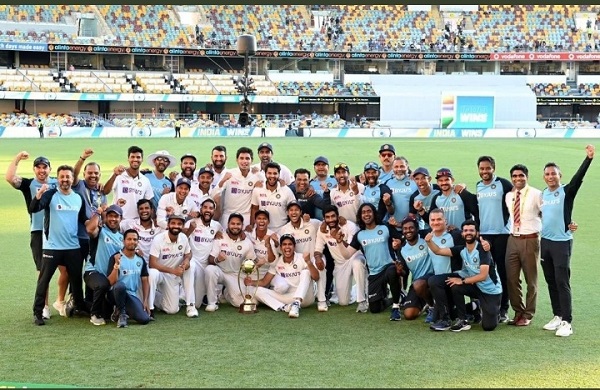
New Delhi, (Samajweekly) India defeated Australia for the second successive time in a Test series in two years, with both the series wins coming in Australia.
Here are the six main reasons that helped the underdogs and injury-stricken India beat host Australia 2-1 in the four-match series that ended on Tuesday:
1. Indian Premier League (IPL) — The T20 has removed the Indian players’ inhibitions against Australians while giving access to top Aussie brains in dressing rooms at nets. All four teams that made the IPL play-offs this season — Delhi Capitals (Ricky Ponting), Mumbai Indians (Andrew McDonald), Royal Challengers Bangalore (RCB, Simon Katich) and SunRisers Hyderabad (David Warner as captain) — had Aussies at the forefront to guide them. Most of these persons were also part of the Aussie team in some position or the other during the just-concluded series.
India player Rishabh Pant, who made 89 not out on the last day at the Gabba, has gained immensely under Ponting while both Mohammed Siraj (fifer in second innings in Brisbane) and Washington Sundar (62 and three wickets in first innings and 22 in second innings) have been under Katich’s wings at the RCB where Aussie limited-overs captain Aaron Finch also plays. That apart, the presence of top Aussie players in different teams have also helped. Shubman Gill, who hit 91 on the last day, has faced Pat Cummins regularly at the KKR nets while Josh Hazlewood and Shardul Thakur, who picked seven wickets and hit 67 in first innings, have also shared the ball at the Chennai Super Kings nets.
2. Strong bench — Since 2010, India A have played 52 first-class matches, the most by any team in the world. Pace bowler Mohammed Siraj has played 16 first-class matches, batsman Shubman Gill eight, Hanuma Vihari 12 and Rishabh Pant four for India A and toured overseas also. Pace bowler Shardul Thakur, who too has played a few games for India A, credited those games for ensuring proper preparation for the senior team. This is apart from the List A games.
“We were here in Brisbane in 2016. We played a couple of four-day games at the Allan Border Field. Though the pitch there is different, at least you get used to the climate. You get used to the Australian conditions. So, when you take that leap from India A to India team, the transition is not that difficult,” said Thakur after the third day’s play. That apart, Rahul Dravid’s policy of letting one batch play only one under-19 World Cup has ensured there is a regular flow of young players with a taste of some form of international cricket. Dravid has been grooming the second string quite well, providing them exposure.
3. Frequent tours to Australia — The Indian team has toured Australia four times in the last 10 years. This is apart from the ‘A’ tours that the Indians have undertaken to the country. India’s last tour to Australia came in 2018-19, just two years ago. The frequent trips have ensured that the players have become used to the conditions Down Under — weather as well as pitches and did not need much time to get acclimatised to the conditions.
4. Covid-19 — The Indian squads for all three formats reached Australia together. The Test team benefited the most as they arrived in Australia over a month before the series was to start. The one-month long stay helped the team get acclimatised to the conditions. They also played a couple of warm-up games ahead of the series. T Natarajan, Shardul Thakur and Washington Sundar who stayed back as net bowlers too got time to get used to the conditions.
5. Competition within the team — The intense competition for places in the squad has helped players grab opportunity with both hands. When Prithvi Shaw was dropped after the first Test, youngster Shubman Gill walked into the squad and grabbed the opportunity with both hands and returned with 259 runs at 51.8. Rishabh Pant’s place was also questioned due to his poor wicketkeeping skills but he performed with the bat to cement his spot.
6. Domestic cricket — India’s well laid out domestic cricket structure, comprising Ranji Trophy, Duleep Trophy, and Irani Trophy in multi-day format, allowed a lot of players to get plenty of cricket under their belt before they made their Test debut. Shardul Thakur, Mohammed Siraj, T Natarajan, Navdeep Saini, who all showed no nerve while playing their first full Test series, all made their first-class debut at least five years ago and have been frontline bowlers for the state sides. The Indian domestic cricket has also provided flat, batting-friendly pitches and that has helped batsmen get confidence to play shots and bowlers to bowl tight, something that helped on the flat Australian pitches.









